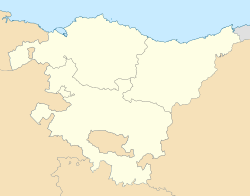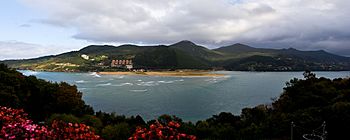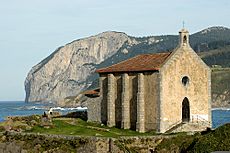Mundaka facts for kids
Quick facts for kids
Mundaka
Mundaca
|
||
|---|---|---|
| Mundaka | ||
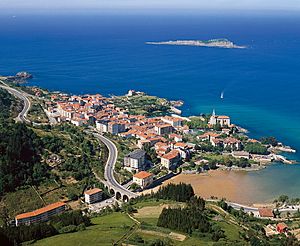
Mundaka and Izaro Island
|
||
|
||
| Country | ||
| Autonomous community | ||
| Province | Bizkaia | |
| Comarca | Busturialdea | |
| Area | ||
| • Total | 4.15 km2 (1.60 sq mi) | |
| Elevation | 3 m (10 ft) | |
| Population
(2018)
|
||
| • Total | 1,835 | |
| • Density | 442.2/km2 (1,145.2/sq mi) | |
| Demonym(s) | Spanish: mundaqués | |
| Time zone | UTC+1 (CET) | |
| • Summer (DST) | UTC+2 (CEST) | |
| Postal code |
48360
|
|
| Official language(s) | Basque Spanish |
|
Mundaka (also known as Mundaca in Spanish) is a small town and municipality in northern Spain. It's located in the province of Biscay, which is part of the Basque Country. Mundaka is famous around the world for its amazing surfing waves. These waves are created by special ocean conditions near its coast.
You can easily get to Mundaka from Bilbao by train using the EuskoTren E4 Urdaibai line.
Contents
- A Look Back in Time: Mundaka's History
- Symbols of Mundaka: Coat of Arms and Flag
- What's in a Name? The Story of Mundaka
- Where is Mundaka? Physical Geography
- Getting to Mundaka
- How Many People Live Here? Population
- What Mundaka Does: Economy
- Famous People from Mundaka
- Fun in Mundaka: Culture and Tourism
- Sports in Mundaka
- Fun Times: Parties and Events
- See also
A Look Back in Time: Mundaka's History
Mundaka is a very old and important place in the history of the Lordship of Biscay. This was a powerful region in the past. People believe that Jaun Zuria, the very first Lord of Biscay, was born here. Legend says his mother was a Scottish princess who came to Mundaka after escaping from an English king.
The name "Mundaka" might even have Danish roots. Some people think Vikings might have visited or lived here a long, long time ago. Mundaka is also said to have the oldest church in Biscay. Because of its long history, it was the first place where the region's main parliament, called the General Parliament, would meet.
The town grew around its port, which was its main center. Many houses in Mundaka are very old, built in a medieval style for fishermen, facing the sea.
Mundaka was first mentioned in official writings in 1051. Later, in 1811, French soldiers occupied the town during the Peninsular War. British ships helped to evacuate the town during this time.
Symbols of Mundaka: Coat of Arms and Flag
- Shield: Mundaka's coat of arms shows an oak tree with a gold background and a wolf. This design is surrounded by a red and grey checkerboard pattern.
- Flag: The flag of Mundaka is made of red silk with beautiful gold embroidery.
What's in a Name? The Story of Mundaka
There's a famous legend about how Mundaka got its name. It comes from the Latin words "munda aqua," which mean 'clean water.' This story was written down in the 15th century.
The legend says that a ship carrying a Scottish princess arrived on Mundaka's coast. She had been sent away from her home. The Scots on the ship called the place "Munda aqua" because they found a spring of very clean water there. This was a big contrast to the muddy waters of the Urdaibai estuary. This princess supposedly had a son, Jaun Zuria, who became the first Lord of Biscay. This legend might also explain why Mundaka is seen as the most important old town in Biscay.
Besides legends, the true origin of the name "Mundaka" is not fully known. The first time Mundaka was written down was in 1070.
Some people think the name might come from Norse (Viking) words. In Danish, "mund" means "mouth," and "haka" means "promontory" or "cape." Mundaka is right at the mouth of the Oka river estuary.
Others believe the name is much older, possibly from a time when Celtic people lived in the area. The ending "-aka" is common in Basque place names.
The town's name was traditionally spelled "Mundaca" in Spanish. But today, it's more often spelled "Mundaka" to fit the modern rules of the Basque language. Since 1982, "Mundaka" has been the official name of the municipality.
People from Mundaka are called "mundaqués(a)" in Spanish and "mundakarra" in Basque.
Where is Mundaka? Physical Geography
Mundaka is located right on the coast. To its west is the town of Bermeo, and to its south is Pedernales. To the east and north is the Cantabrian Sea. Near its coast are the island of Ízaro and the large sandy area of Laida.
The town itself is built around its port. It sits at the foot of Mount Katillotxu (about 337 meters high). A small creek called Errekatxu flows through Laidatxu beach.
Because it's on the coast, Mundaka has a mild climate all year. It rarely gets very cold or has frost. The Oka River, also known as the Mundaka River, flows between the town of Laida and Point Santa Catalina de Mundaka.
Getting to Mundaka
- By Road: You can reach Mundaka from Bilbao using the N-631 road, or from Amorebieta using the N-635.
- By Train: There's a railway line connecting Bilbao to Bermeo that stops in Mundaka.
- By Bus: Bus services also run between Bilbao and Bermeo, stopping in Mundaka.
- By Sea: Mundaka has a port.
- Ferry: In summer, a ferry connects the town with Laida beach.
How Many People Live Here? Population
People have lived in this area for a very long time, even since the Stone Age. Evidence of early human life has been found in nearby caves like Santimamiñe.
The Romans also came here, attracted by the marble from Ereño. Some people think Vikings might have lived here too, which could explain why some people on the Basque coast have blond hair and blue eyes.
In 1876, about 2,000 people lived in Mundaka. The population grew to its highest point in 1911, with 2,284 residents. Over the years, the number of people living in Mundaka has changed due to different economic and social reasons. In 2021, the population was around 1,859 people.
What Mundaka Does: Economy
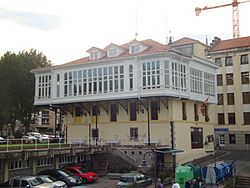
Historically, Mundaka was a fishing town. It had an important group of fishermen called a Guild. However, fishing is not a big industry here anymore.
There wasn't much industry in Mundaka in the past, except for a shipyard. But in 2002, a fish canning factory opened near the port of Bermeo. Also, a new industrial area called Lamiaran opened in 2003.
Today, the main part of Mundaka's economy is tourism, especially in the summer. During summer, the population can become five times larger! Mundaka has many bars, restaurants, and hotels. There's also a top-rated campsite with bungalows. The tourist season continues into the fall because of all the surfers who come to enjoy the waves.
Famous People from Mundaka
- Jaun Zuria: According to legend, he was the first Lord of Biscay.
- Gregorio Blasco: A famous football goalkeeper.
- Edorta Jimenez: A writer of Basque literature.
- Irati Jimenez: Another author of Basque literature.
Fun in Mundaka: Culture and Tourism
Delicious Food
Because Mundaka is a coastal town, the main dish is fish. The bass from Mundaka is especially famous and delicious!
Important Buildings and Monuments
- Library: This building used to be a hospital for pilgrims traveling the Camino de Santiago (Way of St. James).
- Chapel of Santa Catalina: Built in the 19th century, this chapel is on a peninsula. The walls around it are what's left of a 19th-century fort.
- St. Mary's Church: This church is located on a high point in the village, facing away from the sea. It started as a Romanesque church in the 10th century. After being destroyed, it was rebuilt in the Gothic style in the 16th century. Inside, it has amazing art.
- Cross of Kurtzio: This cross from the 17th century is in the square named after it.
- Society Fraternity Mundaquesa (Casino): A historic building.
- Palace of Larrínaga: Another important historical building.
- Old Town: The area around the port is the oldest part of the town.
- Town Hall: The local government building.
Natural Beauty
Mundaka is located at the northern end of the Biosphere Reserve of Urdaibai. This means it's in a very special natural area. You can find two amazing viewpoints here: one in Portuondo and another in the town itself. From these spots, you can see the sandy beaches and the mouth of the Mundaka estuary. This is also where a path begins that follows the estuary all the way to Guernica.
Sports in Mundaka
Surfing
Mundaka is known worldwide for its incredible surfing waves. Huge waves from the Bay of Biscay crash into the rocky coast of the Basque Country. The special sandbar at the mouth of the estuary in Mundaka creates perfect, hollow waves. You can watch these waves from the town's harbor wall. Mundaka used to be one of the places where the World Championship Tour of Surfing was held.
Many famous surfers have ridden the waves at Mundaka, including Andy Irons, Taj Burrow, Bobby Martinez, Kelly Slater, Mark Occilupo, and Joel Parkinson.
Fun Times: Parties and Events
- Carnival Sunday – "Aratuste": A lively celebration before Lent.
- 23 June – Sanjuanada: This is a Midsummer celebration with bonfires and the burning of a witch figure. It's an old tradition that goes back to times before Christianity.
- 29 June – San Pedro: A local feast day.
- 22 July – Magdalena: Another local celebration.
- Last week of August – "Euskal Jaia" (Basque party): This is a big Basque festival with costumes, a craft market, music, demonstrations of Basque rural sports ("Herri-kirolak"), and Basque pelota games.
- 1 November – Txakoli day: A day to celebrate the local Basque wine called Txakoli.
- 25 November – Catherine party Isla de Santa Catalina: A celebration on Santa Catalina Island.
See also
 In Spanish: Mundaca para niños
In Spanish: Mundaca para niños



